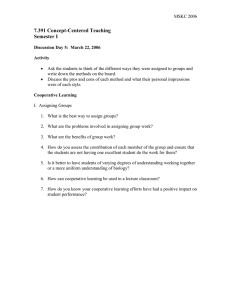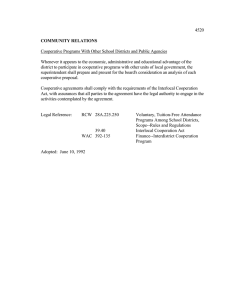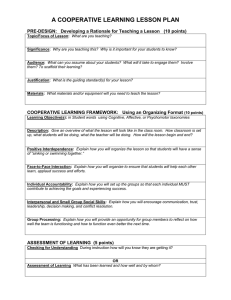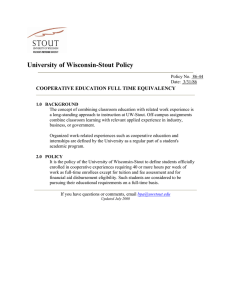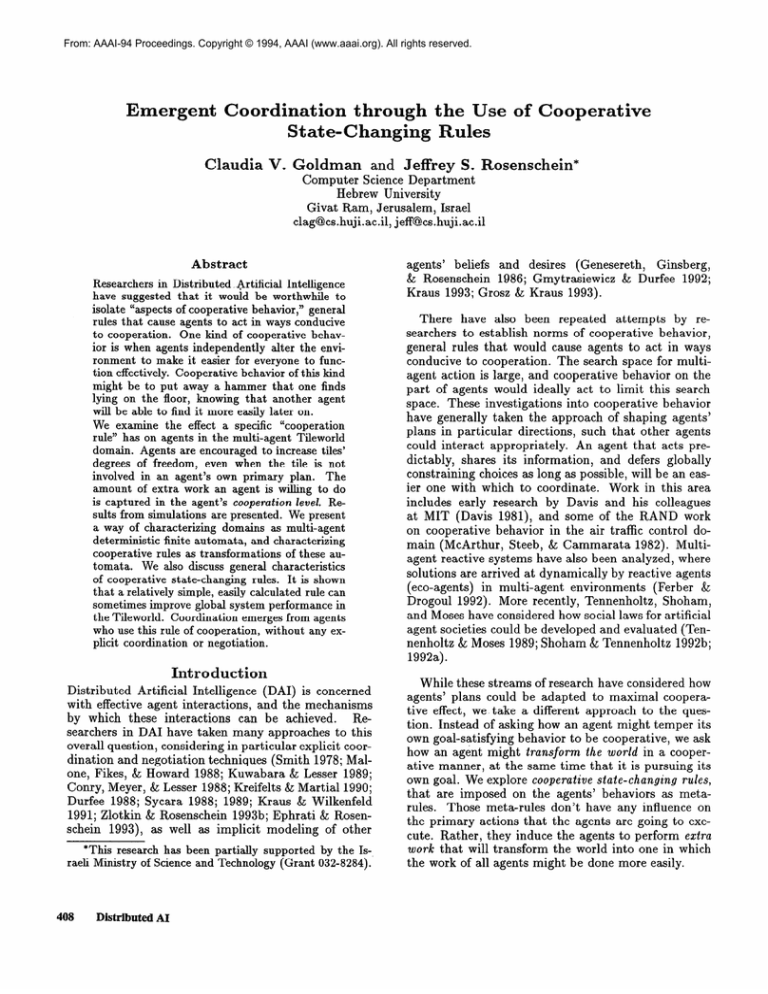
From: AAAI-94 Proceedings. Copyright © 1994, AAAI (www.aaai.org). All rights reserved.
Emergent Coordination through the Use of Cooperative
State-Changing Rules
Claudia
V. Goldman
and Jeffrey S. Rosenschein*
Computer Science Department
Hebrew University
Givat Ram, Jerusalem, Israel
clag@cs.huji.ac.il, jeff@cs.huji.ac.il
Abstract
Researchers in Distributed &tificial Intelligence
have suggested that it would be worthwhile to
isolate “aspects of cooperative
behavior,” general
rules that cause agents to act in ways conducive
to cooperation.
One kind of cooperative
behavior is when agents independently
alter the environment to make it easier for everyone to function effectively. Cooperative
behavior of this kind
might be to put away a hammer that one finds
lying on the floor, knowing that another agent
will be able to find it more easily later on.
We examine
the effect a specific
“cooperation
rule” has on agents in the multi-agent
Tileworld
domain. Agents are encouraged
to increase tiles’
degrees of freedom,
even when the tile is not
involved in an agent’s own primary plan.
The
amount of extra work an agent is willing to do
is captured
in the agent’s cooperation level. Results from simulations
are presented.
We present
a way of characterizing
domains as multi-agent
deterministic
finite automata,
and characterizing
cooperative
rules as transformations
of these automata.
We also discuss general characteristics
of cooperative
state-changing
rules. It is shown
that a relatively simple, easily calculated rule can
sometimes improve global system performance
in
the Tileworld.
Coordination
emerges from agents
who use this rule of cooperation,
without any explicit coordination
or negotiation.
Introduction
Distributed Artificial Intelligence (DAI) is concerned
with effective agent interactions, and the mechanisms
by which these interactions can be achieved.
Researchers in DA1 have taken many approaches to this
overall question, considering in particular explicit coordination and negotiation techniques (Smith 1978; Malone, Fikes, & Howard 1988; Kuwabara & Lesser 1989;
Conry, Meyer, & Lesser 1988; Kreifelts & Martial 1990;
Durfee 1988; Sycara 1988; 1989; Kraus & Wilkenfeld
1991; Zlotkin & Rosenschein 199310;Ephrati & Rosenschein 1993), as well as implicit modeling of other
*This research has been partially supported
raeli Ministry of Science and Technology
(Grant
408
DistributedAI
by the Is032-8284).
agents’ beliefs and desires (Genesereth, Ginsberg,
& Rosenschein 1986; Gmytrasiewicz & Durfee 1992;
Kraus 1993; Grosz & Kraus 1993).
There have also been repeated attempts by researchers to establish norms of cooperative behavior,
general rules that would cause agents to act in ways
conducive to cooperation. The search space for multiagent action is large, and cooperative behavior on the
part of agents would ideally act to limit this search
space. These investigations into cooperative behavior
have generally taken the approach of shaping agents’
plans in particular directions, such that other agents
could interact appropriately. An agent that acts predictably, shares its information, and defers globally
constraining choices as long as possible, will be an easier one with which to coordinate. Work in this area
includes early research by Davis and his colleagues
at MIT (Davis 1981), and some of the RAND work
on cooperative behavior in the air traffic control domain (McArthur, Steeb, & Cammarata 1982). Multiagent reactive systems have also been analyzed, where
solutions are arrived at dynamically by reactive agents
(eco-agents) in multi-agent environments (Ferber &
Drogoul 1992). M ore recently, Tennenholtz, Shoham,
and Moses have considered how social laws for artificial
agent societies could be developed and evaluated (Tennenholtz & Moses 1989; Shoham & Tennenholtz 1992b;
1992a).
While these streams of research have considered how
agents’ plans could be adapted to maximal cooperative effect, we take a different approach to the question. Instead of asking how an agent might temper its
own goal-satisfying behavior to be cooperative, we ask
how an agent might transform the world in a cooperative manner, at the same time that it is pursuing its
own goal. We explore cooperative state-changing
rules,
that are imposed on the agents’ behaviors as metarules. Those meta-rules don’t have any influence on
the primary actions that the agents are going to execute. Rather, they induce the agents to perform extra
work that will transform the world into one in which
the work of all agents might be done more easily.
Tileworld
Interactions
The Domain
Consider agent interactions in a multi-agent version of
the Tileworld (Pollack & Ringuette 1990). Agents can
move only through navigable discrete squares; moving from one square to another costs one unit. Agents
are programmed to roam the grid and push tiles into
holes. In our simulations, we considered two ways in
which agents decide which tile to go after. In one
variation, they choose the closest (Euclidean distance)
tile, compute and traverse their path to it, then push
it to the hole that is closest to the tile (again, Euclidean distance). The computation of distance is a
(lower-bound) heuristic, since it doesn’t take into account barriers, other agents, and tiles (but it is quick
to compute). In the second variation, agents are assigned tiles and holes arbitrarily by the programmer,
and stop when they finish their assignments. This use
of the Tileworld is non-standard, in that we are not focusing here on the architecture (reactive or otherwise)
of the agents. Instead, we are using the Tileworld as
an interesting, constrained domain that helps us understand implicit cooperative behavior.
Strongly-Coupled
Interactions
The goals of separate agents in the multi-agent Tileworld are highly interconnected, primarily because the
constraints on movement are so severe. Agents need
to laboriously go around barriers to get into position
and push a tile into a hole. Consider, for example, the
simple interaction shown in Figure 1 (a variation of an
example from (Zlotkin & Rosenschein 1993a)).
hi
a hole
Ai
an agent
a tile
t- a barrier
4
9
Figure 1: Strongly-Coupled
Interactions
Assume that agent Al wants to fill holes 1 and 2, and
that agent A2 wants to fill holes 2 and 3 (perhaps the
agents were assigned these goals a priori).
For either
agent to accomplish its goal, it would need to carry out
a large number of movements to position the tiles and
itself appropriately. For example, for A1 to fill its holes
alone, it needs to move 17 steps (assuming A2 is not
in its way). Similarly, AZ, alone in the world, would
need to move 26 steps to fill its holes. However, if they
work together, they can satisfy Al completely (and Aa
partially) by going 12 steps (or satisfy As completely
and Al partially).
The highly constrained nature of the multi-agent
Tileworld provides ample opportunity for cooperative
behavior, as the above example shows (e.g., one agent
pushes a tile away from a barrier, while the other then
pushes it perpendicularly).
However, finding these
multi-agent optimal plans tends to be a very difficult
task. Instead, we examine the possibility that the cooperative behavior exhibited in the above example can
be approximated by giving the agents an inclination
towards sociable behavior. We will induce this kind of
behavior through a meta-rule that causes the agents to
help one another implicitly, without having to search
for an optimal multi-agent plan. Ideally, when the
agents are acting sociably, their combined activity will
approach the optimal solution that they would have
found had they carried out full multi-agent planning,
but at a fraction of the computational cost.
A Rule for Sociable
Tileworld
Behavior
in the
In general, a rule for sociable behavior can take several
forms. In the simplest case, an agent may have two
courses of action that he perceives as equivalent; if
other agents would prefer him to carry out specifically
one of those courses of action, he might do so in order
to be cooperative. Sometimes, however, we may design
agents to actually carry out extra work, to improve
the environment for other agents (the amount of extra
work subject to the designer’s discretion). This latter
kind of rule is the one that interests us here.
Obviously, if one designer is building all agents, as in
a cooperative problem solving scenario, then such a cooperative meta-rule will have clear utility if it improves
overall system performance. If separate designers, with
separate goals, are building the agents, there may still
be justification for their putting in such a meta-rule,
under certain circumstances; however, we do not consider these issues (such as stabiZity of the cooperative
rule) in this paper.
In the Tileworld domain, it is better for every agent
to have tiles freely movable, i.e., less constrained by
barriers, so that tiles can be pushed into holes more
easily. Each tile has a degree of freedom associated
with it, the number of directions in which it can be
pushed, either zero, two, or four. When we want agents
to act cooperatively, we induce them to free tiles, by
increasing the tiles’ degree of freedom from two to four.
The key point in any given domain is to identify the
state characteristics that allow goals to be achieved
more easily. Cooperative agents are those that tend
towards moving the world into these more conducive,
less constrained configurations.
In general, a world
with more freed tiles is better than one that has constrained tiles. Although it may not be cheap for an
agent to free a given tile, it may sometimes be possible
to exert a small amount of extra effort, free a tile, and
save another agent a large amount of work. In particular, if agent Ai is on its way to push a tile into a
hole, and there is a constrained tile close by that can
be freed, then the agent might free it.
Coordination
409
This kind of cooperation does not require that the
agents communicate, nor that they have a model of the
other agents’ specific plans, beliefs, or goals (though
we do assume that agents know the current status of
the grid) . Cooperation will emerge out of the sociable
behavior of the individual agents.
How much extra work should an agent be willing to
do to act sociably? In our domain, how close does a
constrained tile need to be for an agent to go out of
its way and free it? In general, the extra work that
the agent may do is the movement outside one of its
minimal paths and back, so as to free a tile. We call
this amount of extra work the cooperation level of the
agent.
Simulations
We have run simulations using the MICE distributed
agent testbed (Montgomery et al. 1992) to statistically analyze the efficacy of different cooperation levels (Hanks, Pollack, & Cohen 1993).
holes. Total work: 11 for Al and 13 for A2 (instead of
17 for each when there is no cooperative rule in force).
It’s important to emphasize that A2 does not push tiles
because it understands that Al will use them-it
is
simply using the cooperative rule (Aa had a cooperation level of 2 for this scenario). The optimal solution,
created perhaps by a central planner, would actually
have saved the agents some work; that solution would
consist of only 12 steps (5 for A2 and 7 for Al), but
require a great deal more effort to find. In the optimal
solution, AZ does not run after tiles that Al eventually
pushes into holes.
Scenario Two:
In the second scenario, agents are
blocked from their closest tiles by a barrier. As they
move around the barrier, another agent prepares the
target tile by pushing it to the end of the barrier. With
Al’s cooperation level set at 8, AZ’S level set at 4, and
As’s set at 0, the work is accomplished in 37 steps (as
opposed to 48 for the non-cooperative solution). The
extra work undertaken by Al benefits AZ; the extra
work undertaken by AZ benefits AS. The optimal solution, more difficult to compute, takes 28 steps.
Experimental
4
Scenario
One
Scenario
Troo
Figure 2: Simulations
In all the experiments, the agents have positive,
static and predefined cooperation levels. At each tick
of time, the agent tries to free a constrained tile that
is different from the one it is pushing into a hole, such
that the sum of the costs of the paths from the agent
location to the constrained tile, freeing the tile, and
going back to its original position (to continue with its
original task) is not larger than its cooperation level.
We first discuss the impact of the cooperative rule,
presented above, for two specific scenarios (see Figure 2). These are illustrative of general ways in which
the rule can generate cooperative activity. Then we
present additional results gathered from using the rule
in randomly generated Tileworlds.
Scenario One: The aim of each agent in this example
is to fill as many holes as it can. Both agents are by
design trying to get to their closest tile. In the first
scenario, the-tiles‘are at a di.agonal to their final holes;
since agents can’t push tiles diagonally, it is more efficient for one agent to position the tile while the other
pushes it without any repositioning necessary. Here,
AZ positions both tiles (getting the “assist”), while Al
actually does the work of pushing the tiles into the
410
DistributedAI
Results
We have run agent experiments on 74 randomly generated Tileworlds. All the worlds consisted of 4 agents, 6
holes, 6 tiles and 8 barriers. Each agent’s primary goal
is to push the closest tile into the closest hole. The
worlds differed from one another by the length of the
barriers (l-4) and by the locations of the agents, the
holes, the tiles, and the barriers, all of which were determined randomly. We computed the number of steps
that each agent carried out in pushing as many tiles as
it could into the holes that were spread in an 11 * 11
grid. The simulation stopped when there were no more
tiles or holes left, or whenever the number of time ticks
was 400. For each world, the agents’ performance was
tested with the agents being given cooperation level
0, cooperation level 1, and so on, up to and including
cooperation level 8. In each of the 666 simulations (74
worlds by 9 cooperation levels), all agents were given
the same cooperation level.
In 13 worlds, we found that the minimum number
of steps done by the group of agents with some strictly
positive cooperation level was less than the total work
done by non-cooperative agents. In only 4 worlds was
being cooperative actually harmful, i.e., agents cumulatively carried out more total steps to fill up the holes
with any strictly positive cooperation level. In the
other 57 worlds, the agents went the same number of
steps when they behaved cooperatively and when they
were given zero cooperation level. Therefore, in 17.56%
of the worlds we tested, positive cooperation level was
beneficial.
How confident can we be that this percentage reflects the real state of affairs for the overall space of
worlds we were testing (i.e., 4 agents, 6 holes, etc.)?
Using elementary statistical theory, we find that we
can have 95% confidence that the error in probability
will be less than 4.42% plus or minus for a sample size
of 74 worlds (meaning we have 95% confidence that
the real percentage of targeted worlds where a positive
cooperation level is beneficial lies between 13.14% and
21.98%). Had we wanted to decrease the bound on the
error of estimation to 2% plus or minus, we would have
needed to exhaustively check 362 randomly generated
worlds; to decrease the bound to 1% plus or minus, we
would have needed to check 1448 worlds.’
The simulations were run with agents programmed
to push the closest tile into the nearest hole; the
chances that they would pass sufficiently close to another (constrained) tile to activate the cooperation rule
were fairly small. Were the cooperation level sufficiently high, of course, an agent would wander far off
his path to free tiles, but then it is likely that the overall performance of the group would decrease (since so
much extra work is being squandered on cooperation).
One can imagine other scenarios where the likelihood
of finding tiles to free would be increased-for example,
if the agents were sent to push arbitrary preassigned
tiles (instead of the closest tile), and might pass other,
closer, tiles on the way. In these cases, beneficial cooperation is likely to be more prevalent.
What is striking about the above, simple, experiment, is just how often a primitive, easy-to-calculate
cooperative rule benefited the group as a whole. The
improved performance was achieved without complicated computation or communication among the
agents and the rule itself was easily identifiable for the
domain. However, how would we, in general, discover
suitable cooperative rules for different domains? The
following section explores this question.
Cooperative
Rule Taxonomy
Which kinds of rules can be designed for a given domain? Which domain characteristics are relevant for
designing cooperative state-changing rules? We are interested in a general way of framing the problem of cooperative rules, that will make the analysis of a wide
range of domains possible.
We define a multi-agent deterministic finite automaton, based on the standard definition of a deterministic
finite automaton (Lewis & Papadimitriou 1981).
Definition
.l A multi-agent
deterministic
j@ite automaton (MADFA)
is a quintuple M = (K, C, 6, s, F):
0 K is a finite set of states, the set of the multi-agent
world states,
Q C is an alphabet. The letters are the actions that the
agents can ta/lce,
‘This still leaves open the question of which cooperation level should be used in a given world, since all we’ve
shown is that some cooperation
level is beneficial in some
percentage
of worlds.
The optimal cooperation
level may
possibly be discovered
through
a learning algorithm,
but
the question remains for future research.
GB3 : K x z + K is the transition function.
E denotes
(multi-agent)
vectors of C (i.e., multi-agent actions),
s is the initial state of the multi-agent world,
F C K is the set of final states where all the agents’
goals are achieved.
The language accepted by the multi-agent
deterfinite automaton is defined as the set of all
the vector strings it accepts. For example, a word
in the Tileworld domain, with three agents, could
be {{north,south,east)
{north,west,nil)},north
E C, {north,
south, east} E E. We consider two
related multi-agent automata for each domain. One
describes the domain in general, i.e., all the possible
states and transitions that can exist in a given domain (it will be denoted by GMADFA). The second is
a sub-automaton of the first, that includes only those
states and transitions permitted byr the agents’ actual
programmed behavior (that is, the sub-.automaton includes only those potential transitions that might actually occur, given the way agents are programmed to
act; agents may still have a choice at run-time, but the
sub-automaton includes all choices they might make.
It will be denoted by SMADFA.). The specific initial
and final states might change for different examples,
but the same architecture can be studied to find cooperative rules regardless of the details of the examples.
Assuming that the rule designer has sufficient information about the domain, he can formulate these two
automata that describe the domain in general and the
agents’ potential behavior within the domain, and use
the automata to deduce appropriate cooperative rules.
The corresponding automata for two distinct domains follow:The
Tileworld
SMADFA
K is the set of
grid configurations of the Tileworld.
C = {
nil,south,east,north,west).
F is the set of states in
which holds ((#t i1es with degree of freedom > 0) =
0) V (#holes = 0).
The FileWorld
SMA
FA - The FileWorld domain
consists of agents whose goals are to write to and read
from shared files. Whenever an agent performs an action that accesses the file, the file is locked for the other
agents (i.e., they can’t access it). C = {pass-lock, read,
write}.
One agent, having the lock, can perform the
write or read action and move the world into another
state in which it can continue writing or reading indefinitely. If the agent performs puss-lock, then the lock
is passed to another agent.
ministic
The Cooperative
State-Changing
Ikules
The purpose of a cooperative state-changing rule is to
enable agents to improve the world by moving it into a
state in which the agents’ work will be easier. One way
to make the agents’ work easier is to shorten the possible paths in SMADFA leading from an initial state
to a final state. A problem domain considered as an
automaton can help- a rule designer deduce useful cooperative rules. The rules then can be applied to difCoordination
411
ferent specific problems. For example, the cooperative
rule found for the Tileworld above can be imposed on
the agents in different specific scenarios. The given
initial state of a particular Tileworld example doesn’t
matter, nor does it matter what the specific goals of
each agent are; the analysis of how to improve agents’
performance looks at the general actions that they can
execute in the domain. We can shorten the words in
three different ways (i.e., three categories of cooperative state-changing rules) by changing the SMADFA:
1. Find a shortcut by using the existing actions in
the alphabet; i.e., look at GMADFA, at possible states
and transitions, that were not included in SMADFA,
and add them to it,
2. Find a shortcut by adding to the alphabet new
actions that the agents are capable of doing,
3. Cut loops by minimizing the times the agents can
be in a loop. We might choose to parameterize the
actions; thus, cutting loops could be expressed by a
change to C, (i.e., to the parameter that indicates the
number of times the specific action can be taken).
The sociability rule presented for the Tileworld is of
the first kind above-it finds a shortcut using existing
actions, since the agents’ original actions include the
push action. Adding “extra work” to the Tileworld
SMADFA means to explore other states and transitions to them such that-paths from the initial state to
a final state can be shorter.
Passing the lock so that other agents will also have
access to a file can be a cooperative state-changing
rule for the FileWorld. This rule is of the third kind;
it cuts a loop created by an agent who goes on reading
or writing to a file. The FileWorld SMADFA can be
modified by setting a limit to the number of characters
that an agent can- read from or write to a file before
handing over the lock.
To develop appropriate rules for different domains,
and to be able to evaluate these rules, we present below some general characteristics that may prove useful
in creating cooperative state-changing rules:
state dependent - a rule is state dependent if the
extra work that needs to be done can only be accomplished in specific states. For example, in the Tileworld a tile can be freed only if there is a constrained
tile and there is an agent with appropriate cooperation
level that could free it. Therefore, the rule we proposed
above for the Tileworld is state dependent.
- a rule is guaranteed if there is certain
guaracteed
to be no harm (no increased global work) by executing
it. In the Tileworld, the rule we presented is not guaranteed, because the direction to which the tile is freed
is heuristically computed. In the FileWorld, given that
an agent has returned its lock, it is guaranteed that any
other agent could use it and hence benefit from it.
reversible - a rule is reversibze if its effects can be undone. The Tileworld rule is reversible, since any agent
can push a freed tile to be next to a barrier again. In
contrast, adding information to what is known by a
412
DistributedAI
group of agents might be irreversible.
redundant
- a rule is redundant if performing the
extra work encompassed in the rule might cause the
agents to stay in the same state. Consider, for example, the StudyWorld, in which the agents are students.
One of the possible actions to be performed by an agent
is to borrow a book from the library. In this world, a
cooperative rule might consist of a student leaving a
summary of the book he has borrowed from the library. In this case, the same summary might be left
again by another student, making the rule redundant.
resource dependent - a rule is resource dependent
if following it implies the use of consumable resources
(e.g., filling the printer tray with paper, although you
don’t have to print).
Conchlsions
We have presented a “rule of cooperative behavior”
that can sometimes improve overall system performance in the multi-agent Tileworld. Agents are encouraged to move tiles away from barriers (even when
these tiles do not contribute to their primary goal),
as long as the amount of extra work required is not
too great. The addition of this implicitly cooperative
behavior does not require a great deal of extra computation on the part of agents, nor any communication
whatsoever. Cooperation emerges cheaply from agents
acting sociably, without the overhead of negotiation or
coordination. Simulations were run that illustrated the
benefits of this emergent cooperation. Although unlikely to produce optimal behavior (except by chance),
the cooperative rule can improve performance in a nontrivial number of instances.
We have also shown how a world can be characterized by mapping it onto an automaton. We identified
three kinds of cooperative state-changing rules that can
be modeled as changes to the automaton.
The principle of cooperative behavior extends to arbitrary domains, where system designers can identify
aspects of global states that are generally desirable.
In the Tileworld, it is generally desirable that tiles be
unconstrained by barriers. In the blocks world, it is
generally desirable that blocks be clear. The designers
1 of agents can benefit by manufacturing rules of sociable behavior that encourage agents to carry out state
transformations that tend to be socially desirable.
* Future research will examine benefits to the system
when the cooperation level of agents changes dynamically over time (for example, as a penalty mechanism
aimed at uncooperative agents), how the subdivision of
labor might also be affected by cooperative meta-rules,
other criteria for qualifying cooperative rules, and stable sociability rules for multi-agent systems. We are
also interested in looking for ananlytical ways to evaluate the cooperation level for a given domain. One
way is to look at the cost of a task when the agents
cooperate as a function of the cost of the original task,
and to find the cooperation level that minimizes the
new cost. Another way is to regard the cooperative
behavior as a perturbation of the distribution of the
amount of work performed by zero-cooperative agents.
Ninth Workshop
129-161.
Artificial
Lewis, H. R., and Papadimitriou,
ements
References
on Distributed
Inc.
of the theory
Intelligence,
C. H. 1981. ElPrentice-Hall,
of computation.
Conry, S. E.; Meyer, R. A.; and Lesser, V. R. 1988.
Multistage negotiation in distributed planning. In
Bond, A. H., and Gasser, L., eds., Readings in Distributed Artijicial Intelligence. San Mateo, California:
Morgan Kaufmann Publishers, Inc. 367-384.
Malone, T.; Fikes, R.; and Howard, M. 1988. Enterprise: A market-like task scheduler for distributed
computing environments. In Huberman, B. A., ed.,
The Ecology of Computation.
Amsterdam:
NorthHolland Publishing Company. 177-205.
Davis, R. 1981. A model for planning in a multiagent environment: steps toward principles for teamwork. Working Paper 217, Massachusetts Institute of
Technology AI Laboratory.
McArthur, D.; Steeb, R.; and Cammarata, S. 1982.
A framework for distributed problem solving. In Pro-
Durfee, E. H. 1988. Coordination of Distributed Problem Solvers. Boston: Kluwer Academic Publishers.
Montgomery, T. A.; Lee, J.; Musliner, D. J.; Durfee,
E. H.; Damouth, D.; and So, Y. 1992. MICE Users
Guide. Artificial Intelligence Laboratory, Department
of Electrical Engineering and Computer Science, University of Michigan, Ann Arbor, Michigan.
Ephrati, E., and Rosenschein, J. S. 1993. Multi-agent
planning as a dynamic search for social consensus.
In Proceedings of the Thirteenth International Joint
Conference
on Artificial
Intelligence,
423-429.
Ferber, J., and Drogoul, A. 1992. Using reactive
multi-agent systems in simulation and problem solving. In Avouris, N. M., and Gasser, L., eds., Distributed
Artificial
Intelligence:
Kluwer Academic Press. 53-80.
Theory
and Praxis.
Genesereth, M. R.; Ginsberg, M. L.; and Rosenschein,
J. S. 1986. Cooperation without communication. In
Proceedings
Intelligence,
of the National
51-57.
Conference
on Artificial
Gmytrasiewicz, P., and Durfee, E. H. 1992. A logic
of knowledge and belief for recursive modeling: Preliminary report. In Proceedings of the Tenth National
Conference
on Artificial
Intelligence,
628-634.
Grosz, B., and Kraus, S. 1993. Collaborative plans
for group activities. In Proceedings of the Thirteenth
International
Joint
gence, 367-373.
Conference
on Artificial
Intelli-
Hanks, S.; Pollack, M. E.; and Cohen, P. R. 1993.
Benchmarks, test beds, controlled experimentation,
and the design of agent architectures. AI Magazine
17-42.
Kraus, S., and Wilkenfeld, J. 1991. Negotiations
over time in a multi agent environment: Preliminary
report. In Proceedings of the Twelfth International
Joint Conference
on Artificial Intelligence,
56-61.
Kraus, S. 1993. Agents contracting tasks in noncollaborative environments.
In Prbceedings
of the
Eleventh
National
Conference
on Artificial
Intelli-
gence, 243-248.
Kreifelts, T., and Martial, F. 1990. A negotiation
framework for autonomous agents. In Proceedings
of the Second European
Workshop on Modeling Autonomous Agents and Multi-Agent
Worlds, 169-182.
Kuwabara, K., and Lesser, V. R. 1989. Extended protocol for multistage negotiation. In Proceedings of the
ceedings of the National
telligence, 181-184.
Conference
on Artificial
In-
Pollack, M. E., and Ringuette, M. 1990. Introducing
the Tileworld: Experimentally evaluating agent architectures. In Proceedings of The National Conference
on Artificial
Intelligence,
183-189.
Shoham, Y., and Tennenholtz, M. 1992a. Emergent
conventions in multi-agent systems: initial experimental results and observations (preliminary report).
and reasonIn Principles of knowledge representation
ing: Proceedings
ence(KR92).
of the Third
International
Confer-
Shoham, Y., and Tennenholtz, M. 199213. On the
synthesis of useful social laws for artificial agent societies (preliminary report). In Proceedings of the Tenth
National
Conference
on Artificial
Intelligence.
Smith, R. G. 1978. A Framework
ing in a Distributed
Processing
for Problem SolvPh.D.
Environment.
Dissertation, Stanford University.
Sycara, K. 1988. Resolving goal conflicts via negotiation. In Proceedings of the Seventh National Conference on Artificial
Intelligence,
245-250.
Sycara, K. 1989. Argumentation: Planning other
agents’ plans. In Proceedings of the Eleventh International
Joint
Conference
on Artificial
Intelligence,
517-523.
Tennenholtz, M., and Moses, Y. 1989. On cooperation in a multi-entity model. In Proceedings of the
Eleventh International
Intelligence,
918-923.
Joint
Conference
on Artificial
Zlotkin, G., and Rosenschein, J. S. 1993a. Compromise in negotiation: Exploiting worth functions
over states. Technical Report 93-3, Leibniz Center
for Computer Science, Hebrew University.
Zlotkin, G., and Rosenschein, J. S. 19938. A domain
theory for task oriented negotiation. In Proceedings
of the Thirteenth International
Artificial Intelligence, 416-422.
Joint
Conference
Coordination
on
413

